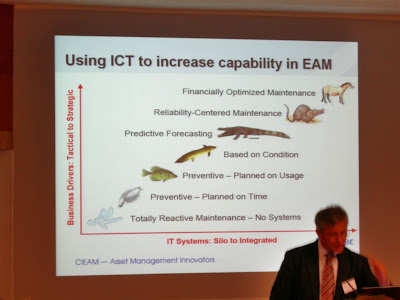
In the beginning, KMB introduction video was shown. Then Mr. K.Y. Ng (Sr. Manager, Maintenance Adm) introduced quality and environmental management system in KMB. KMB is the only public bus company in Hong Kong with ISO 9001 and ISO 14001 certification which are certified by HKQAA.

The history of certification is given as follows:
In 1999, ISO 9001:1994 certification was certified in the following department: KMB Headquarters, Traffic Department and All Maintenance Depots.
In 2002, ISO 9001:2000 certification was certified in the following department: KMB Headquarters, Traffic Department, Four Permanent Operating Depots, Overhaul Centre, Bus Body Construction Depot and Tuen Mun 80 Unit Overhaul Depot.
In 2001 and 2003, Sha Tin Depot and Lai Chi Kok Depot achieved ISO 14001 certification respectively.
Moreover, KMB has been awarded Hong Kong Green Mark Certification by the Hong Kong Q-Mark Council of the Federation of Hong Kong Industries.
Mr. Ng mentioned that there is no quality department in KMB and all staff takes part-time role to contribute in quality management. For ISO execution, a comprehensive “Staff Handbook” and quality standard booklet (in Chinese) were used to communicate with more than 8000 bus captains. Then Miss Lam explained about customer service. KMB employed Customer Feedback Management System and also performed Passenger Satisfaction Survey.
Dr. Albert Tsang (Chairman of HKSQ) presented souvenir to Miss Lam.

After daily services, buses will come back to depot. The first step is to download Octopus info and collect coins. The second step is refueling the bus fully by using the “Posilock” fuel filling system (which used on aircraft). The fill rate is 150L/min and each bus (fill tank capacity ~450L) will take not longer than 3 min to complete refueling. After that, bus will be cleaned by an automatic system for one minute. They have a service commitment to captains that the overall process will be within 5 min.

The history of certification is given as follows:
In 1999, ISO 9001:1994 certification was certified in the following department: KMB Headquarters, Traffic Department and All Maintenance Depots.
In 2002, ISO 9001:2000 certification was certified in the following department: KMB Headquarters, Traffic Department, Four Permanent Operating Depots, Overhaul Centre, Bus Body Construction Depot and Tuen Mun 80 Unit Overhaul Depot.
In 2001 and 2003, Sha Tin Depot and Lai Chi Kok Depot achieved ISO 14001 certification respectively.
Moreover, KMB has been awarded Hong Kong Green Mark Certification by the Hong Kong Q-Mark Council of the Federation of Hong Kong Industries.
Mr. Ng mentioned that there is no quality department in KMB and all staff takes part-time role to contribute in quality management. For ISO execution, a comprehensive “Staff Handbook” and quality standard booklet (in Chinese) were used to communicate with more than 8000 bus captains. Then Miss Lam explained about customer service. KMB employed Customer Feedback Management System and also performed Passenger Satisfaction Survey.
Dr. Albert Tsang (Chairman of HKSQ) presented souvenir to Miss Lam.

After daily services, buses will come back to depot. The first step is to download Octopus info and collect coins. The second step is refueling the bus fully by using the “Posilock” fuel filling system (which used on aircraft). The fill rate is 150L/min and each bus (fill tank capacity ~450L) will take not longer than 3 min to complete refueling. After that, bus will be cleaned by an automatic system for one minute. They have a service commitment to captains that the overall process will be within 5 min.




















































